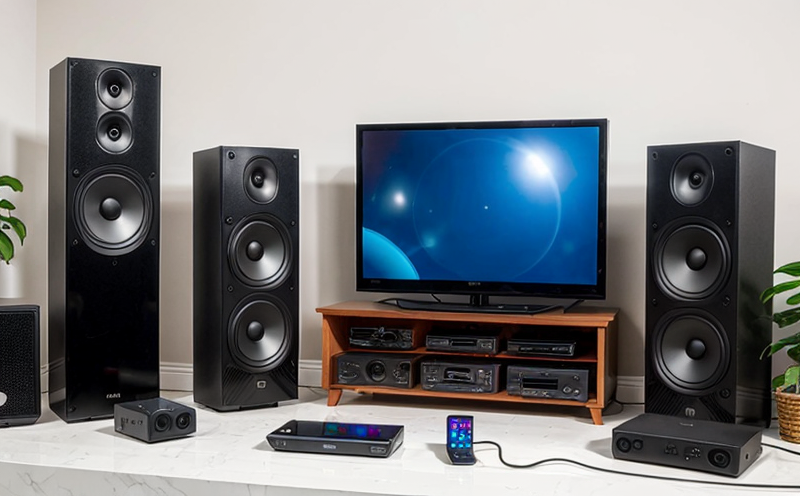ITU R BS 1116 Subjective Audio Quality Testing for Consumer Equipment
The ITU Recommendation R BS 1116 is a standardized method for assessing the subjective audio quality of consumer electronics and audio/video (A/V) devices. This test ensures that audio equipment meets high standards in terms of sound fidelity, clarity, and overall listening experience as perceived by human listeners.
The test protocol outlined in ITU R BS 1116 is designed to evaluate how well different devices reproduce audio signals without introducing any noticeable degradation or distortion. It involves a panel of trained listeners who rate the quality of the reproduced sound against reference standards. The goal is to ensure that consumers can expect consistent and high-quality audio performance from their purchased equipment.
The test process typically begins with selecting a variety of test stimuli, which include different types of music, speech recordings, and other sounds representative of typical consumer listening environments. These stimuli are then played through the devices being tested under controlled conditions. The listeners rate each sample on various parameters such as clarity, loudness, presence, and overall enjoyment.
One key aspect of ITU R BS 1116 is its emphasis on real-world usage scenarios. This means that the tests simulate how people would actually use the equipment in their homes or during other common activities. For instance, if a device claims to provide high-quality sound while playing background music during a television show, it should perform equally well under these conditions.
The ITU R BS 1116 test also considers the impact of various factors on audio quality, such as room acoustics and speaker placement. This ensures that even when used in different environments, the equipment maintains its advertised performance levels. Additionally, the test accounts for variations in listener preferences by providing multiple reference samples to cater to a wide range of tastes.
Another important feature of this testing method is its flexibility. It allows manufacturers to customize their tests based on specific product features or market demands. For example, if a particular model has enhanced bass response, the test can be adjusted to specifically evaluate how well it performs in that area compared to other devices.
The results from ITU R BS 1116 testing provide valuable insights into consumer satisfaction and brand reputation. By ensuring that products meet or exceed these stringent standards, manufacturers can gain a competitive edge in the market. Moreover, compliance with this standard helps companies avoid potential legal issues related to false advertising about audio quality.
For those involved in quality management, compliance officers, R&D engineers, and procurement teams within electronics firms, understanding ITU R BS 1116 is crucial for meeting regulatory requirements and delivering superior products. This testing method not only enhances the technical capabilities of the equipment but also contributes significantly to customer satisfaction.
When implementing ITU R BS 1116 into your workflow, consider working closely with experienced labs that specialize in this type of evaluation. They can help ensure that all aspects of the test are conducted accurately and consistently across different models or generations of products.
Why It Matters
The importance of ITU R BS 1116 cannot be overstated, especially in today’s competitive consumer electronics market. With so many options available to consumers, ensuring that audio equipment delivers on its promises is essential for maintaining brand loyalty and trust.
- Consumer Satisfaction: High-quality audio experiences contribute greatly to customer satisfaction. Products that meet ITU R BS 1116 standards are more likely to resonate with users.
- Market Differentiation: Meeting or exceeding these standards allows companies to differentiate themselves from competitors who may not adhere to such rigorous testing protocols.
- Regulatory Compliance: Many jurisdictions have regulations requiring adherence to international standards like ITU R BS 1116. Failure to comply can lead to penalties and damage to a company's reputation.
- Product Lifecycle Extension: By consistently meeting these quality benchmarks, manufacturers can extend the useful life of their products by ensuring they remain reliable over time.
In summary, ITU R BS 1116 plays an indispensable role in shaping the future of consumer electronics. It ensures that audio equipment meets not only technical specifications but also subjective expectations set by consumers worldwide.
Applied Standards
The International Telecommunication Union (ITU) Recommendation ITU R BS 1116 is widely recognized for its role in evaluating the subjective audio quality of consumer electronics and A/V devices. This standard draws from several international standards, including:
- ISO ISO 226:2003: Sensory threshold of human hearing.
- ASTM F2817-16: Specification for Consumer Electronic Equipment.
- EN 50190: Audio equipment - Specifications and test methods for audio equipment.
- IEC IEC 60268-4: Sound level meters, microphone calibrators and associated instruments - Part 4: Calibration of microphones.
The combination of these standards ensures that the subjective audio quality testing conducted according to ITU R BS 1116 is both robust and consistent across various manufacturers and regions.
Quality and Reliability Assurance
- Consistency: Ensuring that every batch of products meets the required audio quality standards.
- Reliability: Guaranteeing long-term performance without degradation over time or under different conditions.
- User Satisfaction: Meeting customer expectations and delivering on brand promises.
- Compliance: Adhering to regulatory requirements set by international bodies like ITU, ISO, ASTM, EN, IEC, etc.
- Brand Reputation: Maintaining a positive image through consistent product quality.
Quality and reliability assurance are critical components of effective ITU R BS 1116 testing. By focusing on these areas, manufacturers can build trust with their customers while also safeguarding against potential legal issues arising from non-compliance or misleading claims about audio performance.





